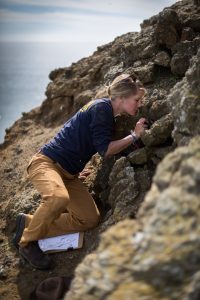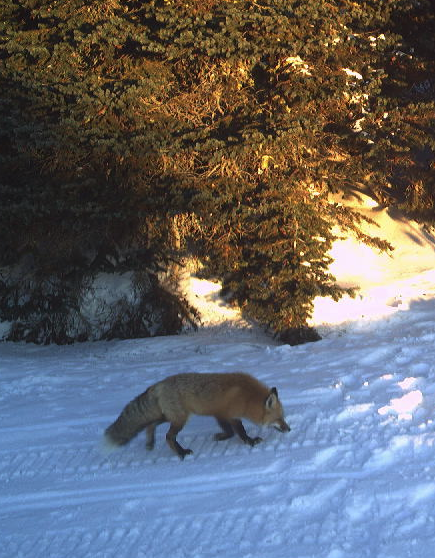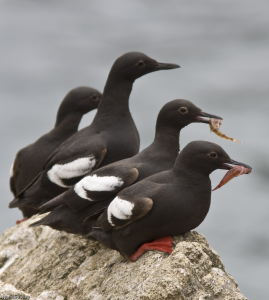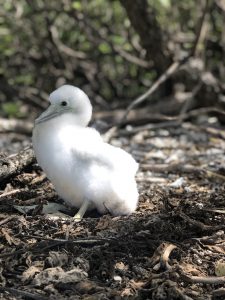To obtain code for completed projects, please look for us on GitHub.
Current Projects
Seabird populations at Channel Islands National Park
Funding: Channel Islands National Park
Collaborators: California Institute of Environmental Studies, Montrose Settlements Restoration Program, U.S. Geological Survey Western Ecological Research Center – Santa Cruz Field Station
Contact: Amelia J. DuVall

Channel Islands National Park provides essential habitat for marine avifauna, including vital nesting and feeding grounds for 99% of the seabirds in southern California and important breeding areas, wintering areas, and migratory stopovers for shorebirds. At least fourteen seabirds and shorebirds use the islands for essential breeding grounds and an additional three are suspected to have bred there historically. There is no current information on the baseline status and trends in demographic parameters and population abundance for several key avifauna at the park. These taxa are being impacted by existing stressors (e.g., disturbance via light pollution and increased park visitation, depredation, loss of nesting habitat) and could be significantly affected by future stressors (e.g., offshore wind energy development, changes in prey distribution and habitat due to climate change). This project fills a critical knowledge gap on the population trends for eight priority taxa identified by Channel Islands National Park for the seabird monitoring program. We are analyzing long-term monitoring data to provide estimates of relative abundance and reproductive success over time as a function of environmental conditions such as sea surface temperature and forage fish abundance. This information will be used to conduct in-depth program reviews to refine the seabird monitoring program and prioritize management and conservation actions.
Seabird ecology and conservation at Tetiaora, French Polynesia
Funding: Private Funders
Collaborators: Dr. Beth Gardner and Dr. Julia Parrish (University of Washington), Tetiaroa Society
Contact: Amelia J. DuVall or Eve Hallock
Seabirds are one of the most endangered groups of birds worldwide. The introduction of mammalian predators to breeding islands, by-catch in fishing vessels, and changing ocean conditions related to climate change all represent threats to seabirds. Tetiaroa, a private atoll in French Polynesia with a land area of only about 6 square kilometers, is home to tens of thousands of breeding seabirds of 10 different species. In this incredible natural laboratory, we are studying pre-rat eradication seabird communities ahead of a planned eradication of rats in 2020. Coupling these pre-eradication studies with post-eradication studies will allow us to better understand the effects of introduced predators and the benefits that may be derived from eradication. We are also initiating a long-term banding program at Tetiaroa in order to track individuals across their lifetimes to better understand the relationships between survival and ocean conditions. Our focal species at Tetiaroa include the red-footed booby (Sula sula), the brown booby (Sula leucogaster), the brown noddy (Anous stolidus), the sooty tern (Onychoprion fuscatus), and the greater crested tern (Thalasseus bergii). In 2020, we also plan to attach GPS tags to the largest of these species – the red-footed booby and the brown booby – to determine where these species forage both during and outside the breeding season.
Assessing threats to the Cascade red fox

Funding: Washington Department of Fish and Wildlife, USGS/NPS Natural Resources Preservation Program, USGS Northwest Climate Adaptation Science Center, National Fish and Wildlife Foundation
Collaborators: Washington Department of Fish and Wildlife; Washington Department of Natural Resources; NPS Mount Rainier National Park; USFS Gifford Pinchot & Okanogan-Wenatchee National Forests; Confederated Tribes and Bands of the Yakama Nation; Cascades Carnivore Project
Contact: Nate Redon
The Cascade red fox (Vulpes vulpes cascadensis; CRF) is an endangered native subspecies of red fox endemic to high elevation sites in the Washington portion of the Cascade Range. The species has experienced a recent dramatic population decline and southward range contraction. The drivers for and extent of these processes is unknown. In Washington, CRF are a Species of Greatest Conservation Need and were recently listed as endangered by the Washington Department of Fish and Wildlife.
There is tremendous uncertainty surrounding the biology and ecology of the CRF. They are understudied, difficult to detect, and occupy remote mountainous terrain. Managers have limited ability to make informed management decisions or to identify the most effective approaches for recovering the CRF. We are capturing and fitting individual foxes with GPS collars to obtain fine-scale information on their habitat use and movement. We will integrate this information with pre-existing camera and scat detection datasets collected by the Cascades Carnivore Project and Mount Rainier National Park using an integrated spatial capture-recapture model. This model will allow us to estimate CRF demography, habitat use, and movement, as well as the effects of key spatial covariates on these processes. We are also working through a structured decision-making process with collaborators to identify and evaluate alternative management strategies for the CRF. This work will inform state and federal managers regarding the status of CRF and the most effective approaches for recovery.
Northwestern pond turtle conservation in Washington
Funding: Washington Department of Fish and Wildlife, NSF Graduate Research Fellowship Program
Collaborators: Washington Department of Fish and Wildlife
Contact: Tim Chen

In Washington, Northwestern pond turtles (Actinemys marmorata; NWPT) have been a focus of conservation efforts for more than four decades. In pursuit of recovery, the Washington Department of Fish and Wildlife (WDFW) has invested heavily in protection, management, and restoration of NWPT populations and habitats. Despite recent successes in increasing the population of NWPT from around 150 individuals in 1994 to around 800-1000 individuals in 2015, downlisting criteria have not been met due to threats impacting various life stages of NWPT. Most notable threats currently faced by NWPT include habitat loss and degradation, a newly emergent fungal disease known as shell disease, predation by introduced American bullfrogs (Lithobates catesbeianus), and climate change. In the face of these major threats, managers at the WDFW are faced with the complex task of continuing to recover NWPT populations under limited resources. There is substantial uncertainty in how to optimally allocate available resources to advance recovery goals, driven partly by the complexity of the problem and partly by uncertainty regarding the severity of threats and the efficacy of management actions. We plan on using both data analysis and population projection models, within a structured decision-making framework, to project the expected effects of threats and alternative management strategies on NWPT viability in Washington. Our work will assist the Washington Department of Wildlife, and other managers, with an improved understanding of how to allocate limited resources to achieve recovery of NWPT in Washington.
Demography and habitat selection of Pigeon Guillemots in Puget Sound, Washington
Funding: USGS Science Support Program; USFWS Pacific Seabird Program; SeaDoc Society, a program of the Karen C. Drayer Wildlife Health Center, School of Veterinary Medicine, University of California, Davis
Collaborators: Guillemot Research Group, US Fish and Wildlife Service, Washington Department of Fish and Wildlife
Contact: Sarah Converse

Pigeon Guillemots (Cepphus columba) are one of only three alcids that nest in Puget Sound. Despite having been identified as an indicator species for the region, little research has been done on the demography of Pacific coast populations. This project is a collaboration with the Guillemot Research Group, a citizen science data collection program that has been monitoring these birds during the breeding season since 2008, as well as Protection Island National Wildlife Refuge, and the Washington Departmetn o. We are engaged in a number of efforts to understand nesting success and how it is impacted by environmental conditions, and to understand threats to foraging habitat for this species. As an indicator species, Pigeon Guillemots are an important component of nearshore ecosystems throughout Puget Sound, likely affected by environmental variability (e.g., pollution, coastal development, and changes in the distribution and availability of local forage fish). This work highlights the importance of citizen science initiatives and will inform ongoing conservation, monitoring, and management efforts for this species, other seabirds, forage fish, and ecosystem resilience throughout the Puget Sound region.
